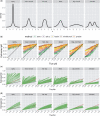False discovery rates: a new deal
- PMID: 27756721
- PMCID: PMC5379932
- DOI: 10.1093/biostatistics/kxw041
False discovery rates: a new deal
Abstract
We introduce a new Empirical Bayes approach for large-scale hypothesis testing, including estimating false discovery rates (FDRs), and effect sizes. This approach has two key differences from existing approaches to FDR analysis. First, it assumes that the distribution of the actual (unobserved) effects is unimodal, with a mode at 0. This "unimodal assumption" (UA), although natural in many contexts, is not usually incorporated into standard FDR analysis, and we demonstrate how incorporating it brings many benefits. Specifically, the UA facilitates efficient and robust computation-estimating the unimodal distribution involves solving a simple convex optimization problem-and enables more accurate inferences provided that it holds. Second, the method takes as its input two numbers for each test (an effect size estimate and corresponding standard error), rather than the one number usually used ($p$ value or $z$ score). When available, using two numbers instead of one helps account for variation in measurement precision across tests. It also facilitates estimation of effects, and unlike standard FDR methods, our approach provides interval estimates (credible regions) for each effect in addition to measures of significance. To provide a bridge between interval estimates and significance measures, we introduce the term "local false sign rate" to refer to the probability of getting the sign of an effect wrong and argue that it is a superior measure of significance than the local FDR because it is both more generally applicable and can be more robustly estimated. Our methods are implemented in an R package ashr available from http://github.com/stephens999/ashr.
Keywords: Empirical Bayes; False discovery rates; Multiple testing; Shrinkage; Unimodal.
© The Author 2016. Published by Oxford University Press.
Figures




References
-
- Benjamini Y. and Hochberg Y. (1995). Controlling the false discovery rate: a practical and powerful approach to multiple testing. Journal of the Royal Statistical Society. Series B (Methodological) 57, 289–300.
-
- Benjamini Y. and Yekutieli D. (2005). False discovery rate--adjusted multiple confidence intervals for selected parameters. Journal of the American Statistical Association 100, 71–81.
-
- Boyd S. and Vandenberghe L. (2004). Convex Optimization. Cambridge, UK: Cambridge University Press.
-
- Carvalho C. M. Polson N. G. and Scott J. G. (2010). The horseshoe estimator for sparse signals. Biometrika 97, asq017.
-
- Cordy C. B. and Thomas D. R. (1997). Deconvolution of a distribution function. Journal of the American Statistical Association 92, 1459–1465.
Publication types
MeSH terms
Grants and funding
LinkOut - more resources
Full Text Sources
Other Literature Sources

